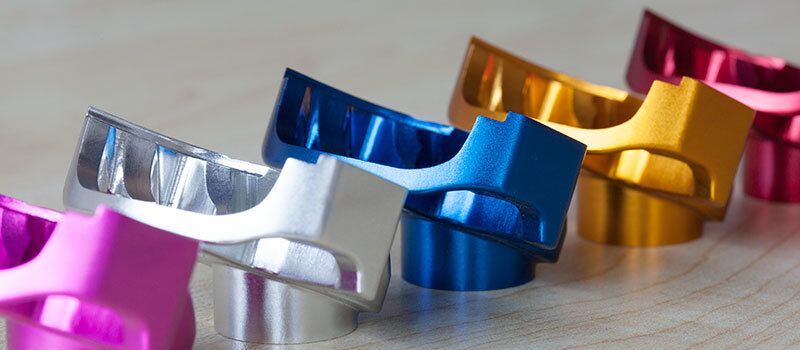Anodizing on Forged or Machined Aluminum Parts
Aluminum is a commonly used material in the production of drop forging and machining. When you’re in need of forged or machined aluminum parts with superior mechanical properties and specialized aesthetic design, anodizing finish is an excellent option. The anodizing process forms a layer of oxide on aluminum parts, effectively increasing corrosion resistance, and also enhancing visual qualities and keeping the surface from being scratched.

In order to properly anodize forged or machined aluminum parts, the surface must first be cleaned and rinsed before getting placed into a bath of an electrolytic solution, primarily either sulfuric or chromic acid. This provides a electrically conductive coating that contains a number of positive and negative ions.
So how does this process really work? Well, once the anodizing process is underway, a positive electric charge is sent through the aluminum, while a negative charge is applied to plates in the electrolyte. Basically, the electric current forces the positive ions to attract to the negatively charged plates while the negative ions are attracted to the forged or machined aluminum part, which the positive anode.
From here, the electrochemical reaction forces pores to open up on the surface of the aluminum so that the positive ions can escape. In a uniformly geometric pattern, these pores dig down into the substrate of the part. The combination of the aluminum surface and negatively charged ions create a barrier layer, which is known in the anodizing aluminum process as the surface layer the makes parts resistant to corrosion.
The anodizing process on forged or machined aluminum parts is commonly used for a wide range of applications, producing parts that you’ll regularly find in aircrafts, consumer goods, sporting equipment and electronics, just to name a few. There are several advantages attract you to do anodizing treatment after aluminum forging or machining.
1. Enhanced corrosion resistance
After anodizing, the surface of forged or machined aluminum parts will form an oxide film, which is a very stable chemical nature with strong corrosion resistance.
2. Multi-colors selection
Anodizing aluminum can effectively absorb a variety of organic or inorganic dyes. So anodized aluminum products can have a variety of bright colors, such as red, yellow, black, bule, etc.
3. Improve the wear resistance
Anodized oxide film can effectively improve the wear resistance of forged or machined aluminum parts.
4. Electrical insulation
Due to the chemical structure of anodized oxide film, the forged or machined aluminum parts will be electrically insulated after anodizating.
After understanding the anodizing process and the benefits, you can decide whether to proceed anodizing treatment for your forged or machined parts. If you need functional and colorful aluminum parts that will face corression or wear, this post-processing technique is ideal to consider. In addition, you can choose any color you like to meet a visual appeal.
Any inquiry on anodizing of forged or machined aluminum parts, pls feel free to contact us!
How Anodizing Works on Forged or Machined Aluminum Parts?

In order to properly anodize forged or machined aluminum parts, the surface must first be cleaned and rinsed before getting placed into a bath of an electrolytic solution, primarily either sulfuric or chromic acid. This provides a electrically conductive coating that contains a number of positive and negative ions.
So how does this process really work? Well, once the anodizing process is underway, a positive electric charge is sent through the aluminum, while a negative charge is applied to plates in the electrolyte. Basically, the electric current forces the positive ions to attract to the negatively charged plates while the negative ions are attracted to the forged or machined aluminum part, which the positive anode.
From here, the electrochemical reaction forces pores to open up on the surface of the aluminum so that the positive ions can escape. In a uniformly geometric pattern, these pores dig down into the substrate of the part. The combination of the aluminum surface and negatively charged ions create a barrier layer, which is known in the anodizing aluminum process as the surface layer the makes parts resistant to corrosion.
The Benefits of Anodizing on Forged or Machined Aluminum Parts
The anodizing process on forged or machined aluminum parts is commonly used for a wide range of applications, producing parts that you’ll regularly find in aircrafts, consumer goods, sporting equipment and electronics, just to name a few. There are several advantages attract you to do anodizing treatment after aluminum forging or machining.
1. Enhanced corrosion resistance
After anodizing, the surface of forged or machined aluminum parts will form an oxide film, which is a very stable chemical nature with strong corrosion resistance.
2. Multi-colors selection
Anodizing aluminum can effectively absorb a variety of organic or inorganic dyes. So anodized aluminum products can have a variety of bright colors, such as red, yellow, black, bule, etc.
3. Improve the wear resistance
Anodized oxide film can effectively improve the wear resistance of forged or machined aluminum parts.
4. Electrical insulation
Due to the chemical structure of anodized oxide film, the forged or machined aluminum parts will be electrically insulated after anodizating.
Should You Anodize Your Forged or Machined Aluminum Parts?
After understanding the anodizing process and the benefits, you can decide whether to proceed anodizing treatment for your forged or machined parts. If you need functional and colorful aluminum parts that will face corression or wear, this post-processing technique is ideal to consider. In addition, you can choose any color you like to meet a visual appeal.
Any inquiry on anodizing of forged or machined aluminum parts, pls feel free to contact us!


 sales@dropforging.net
sales@dropforging.net